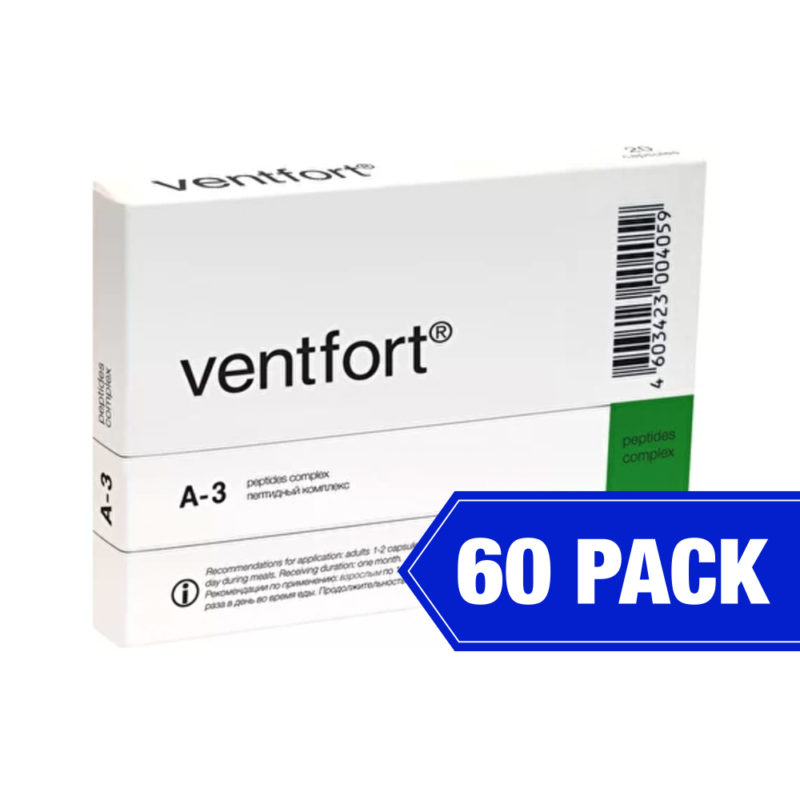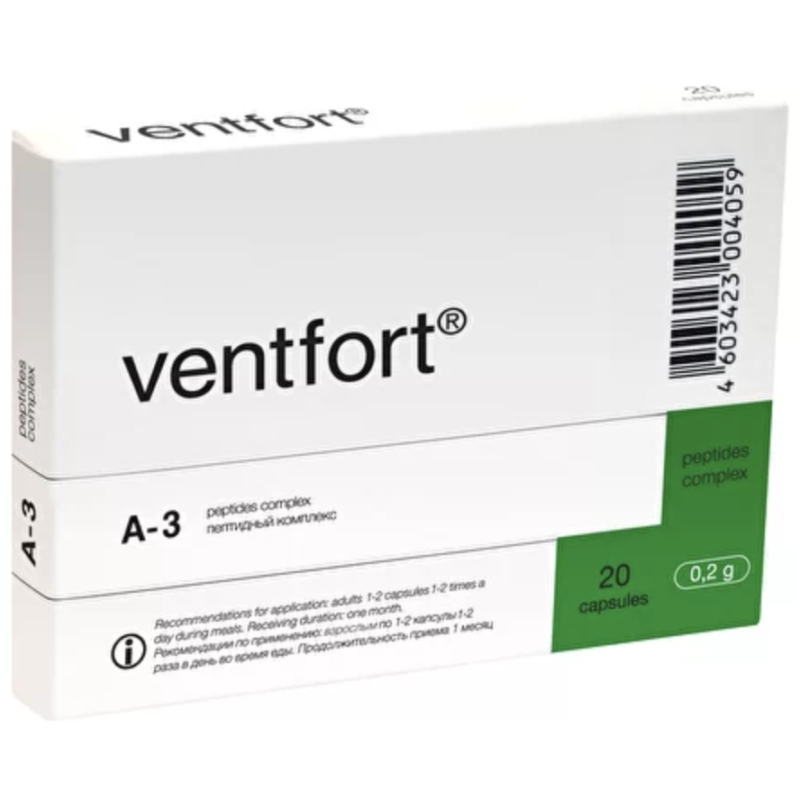REPORT on the results of clinical study of peptide bioregulator Ventfort
Ventfort®
A report of the results of clinical study of the biologically active peptide bioregulator of blood vessel origin:
The biologically active peptide bioregulator Ventfort® contains a complex of low-molecular peptides with molecular weight up to 10000 Da, isolated from the vascular (aorta) tissue of young animals – calves aged up to 12 months.
Ventfort® is manufactures in the form of tablets or capsules with a content of active substances 10 mg.
Experimental studies have shown that the peptides possess tissue-specific action on the cells of the tissues from which they were isolated. They improve trophism of the vascular wall cells and provide regulating action on the metabolic processes in them, provide normalization of functional and morphological changes in the vascular wall, they regulate blood content of cholesterol and lipoproteins, thus decreasing a risk of various vascular defects. So it is possible to extrapolate an efficiency of use of Ventfort® for recovery of vascular function at various diseases, including vascular atherosclerosis.
Atherosclerosis and its consequences is one of the main causes of invalidation and death in developed countries. Age related changes of vascular wall and hemodynamic disorders results in decrease of peripheral blood flow, vascularization of bodies and tissues, development of various components of oxygen insufficiency and trophesies. (2, 3, 4, 6).
Drug treatment of atherosclerosis is aimed at normalization of lipid metabolism, blood coagulation processes and metabolism in the vascular walls (1, 5).
§ Medicines, which normalize cholesterol and b-lipoproteins level.
§ Those drugs which prevent cholesterol absorption in intestines, (cholestiramin, b-sitosterol, diosponine, polysponine).
§ Drugs which affect cholesterol synthesis in an organism, (clofibrate, miscleron, regardin, cetamifen, nicotinic acid, vitamin PP);
§ Those drugs which increase disintegration and excretion of cholesterol from an organism (linetol, arachiden).
§ Others that improve microcirculation and normalize vascular permeability, decrease edema of vascular tissues and improving metabolic processes in the vascular walls, (prodectine, dicynon, doxium, glivenol, escusane etc.)
The clinical studies of Ventfort® were carried out at the Medical Center of the Saint Petersburg Institute of Bioregulation and Gerontology in patients with atherosclerosis of various arteries and senile purpura during the period from November 2003 till February 2004.
Clinical characteristic of the patients
The subjects of the clinical studies were 49 patients with arterial atherosclerosis and senile purpura, 27 of them were the main group (15 men and 12 women) – they were additionally prescribed Ventfort® per os 10-15 minutes before meal 1-2 capsules 2-3 times a day for 10-15 days depending on a degree of pathological process. 22 patients (11 men and 11 women) in the control group have been taking only general purpose medicines. The age of both groups of patients has made from 52 up to 84 years old (Table 1).
The patients of both groups have various clinical signs depending on affection of various caliber vessels: essential hypertension, ischemic heart disease, cerebrovascular disorders with memory impairment, clouded sensorium and affective liability. All the patients had progressive dynamics of pathogenic pathway.
All the patients have been taking symptomatic and pathogenic therapy for specific clinical signs of vascular pathology.
Table 1
Distribution of the patients by clinical entities, sex and age
|
Diagnosis |
Age (years) |
Men |
Women |
In total |
|||
|
control group |
main group |
control group |
main group |
control group |
main group |
||
|
Artery atherosclerosis |
52-71 |
9 |
11 |
6 |
9 |
15 |
20 |
|
Senile purpura |
72-84 |
2 |
4 |
4 |
3 |
7 |
7 |
|
In total |
|
11 |
15 |
10 |
12 |
22 |
27 |
Examination methods
The patient complaints were assessed and compared, general clinical studies of blood and urine were carried out together with blood biochemical test using “REFLOTRON” device (Boehringer Mannheim, Germany). Blood coagulogram and tourniquet Hesse testing were carried out with a purpose of homeostasis assessment.
Examination results
It was established that Ventfort® administration in patients with arterial atherosclerosis has resulted in improvement of general state of health, especially in patients with cerebrovascular disorders.
As you can see in the table 2, Ventfort® administration has resulted in reliable decrease in the level of general blood cholesterol. There were also a tendency towards decrease in the content of very little density lipoproteins, being most atherogenic.
The patients with senile purpura after Ventfort® administration had an increase in strength of capillary walls according to the results of Hesse testing, the frequency of hemorrhages has decreased. In most patients the skin and hair condition has improved.
Table 2
Influence of Ventfort® on the lipid metabolism values in patients with arterial atherosclerosis
|
Parameter |
Before treatment |
After treatment using general purpose medicines |
After treatment using Ventfort® |
|
General cholesterol, (mmol/l) |
8,6±0,4 |
7,2±0,5* |
6,0±0,7* |
|
Very little density lipoproteins, (mmol/l) |
1,32±0,05 |
1,13±0,07 |
0,91±0,07 |
|
Triglycerides, (mmol/l) |
4,7±0,5 |
4,3±0,6 |
4,1±0,6 |
*Р<0.05 reliable=”” in=”” comparison=”” with=”” the=”” parameter=”” before=”” treatment=”” p=””>
Ventfort® administration in patients with senile purpura has resulted in improvement of skin condition and in increase in strength of capillaries, confirmed by Hesse test results. The frequency of hemorrhage marks has decreased.
Thus the results of the study performed testify therapeutic efficiency of Ventfort® and expediency of its application as a part of complex treatment of atherosclerosis and vascular pathology.
Ventfort® administration has not resulted in any side effects, complications, contraindications and drug dependence.
Ventfort® is convenient for administration in hospital, out-patient conditions and at home.
Ventfort® can be used as medical and preventive mean in the form of biologicall active food additive in the form of adjunct for complex therapy of vascular atherosclerosis and improvement of microcirculation in different tissues in combination with any means of symptomatic and pathogenetic therapy.
Conclusion
The biologically active peptide bioregulator Ventfort® provides regulation of blood cholesterol and lipoproteins contents and promotes improvement of vascular wall condition.
Ventfort® is well tolerated at oral administration, does not have any side effects, does not have any contraindication and can be used as an adjunct to complex treatment and prophylaxis of vascular disorders of various geneses.
Ventfort® is recommended for improvement of the function of vascular wall in case of atherosclerosis, microcirculation disorders in the bodies and tissues art various diseases, influence on the organism of various extreme factors. It is also recommended to elderly people for maintenance of the vascular system function.
Recommended dosage
· For atherosclerosis patients – per os 10-15 minutes before meal 1-3 capsules, 2-3 times a day for 10-20 days.
· For senile purpura patients – per os 10-15 minutes before meal, 1-3 capsules, 2-3 times a day for 10-30 days.
· It is expedient to carry out the treatment courses every 3-6 month.
References
1. Belousov Y.B., Moiseev V.S., Lepakhin V.K. Clinical pharmacology and pharmacotherapy: Manual for doctors. – M.: Universum, 1993. – 398 pages.
2. Blood diseases in elederly people: Translated from English/ Edited by M. G. Danham, I. Chanarina. – M.: Medicine, 1989. – 352 pages.
3. Hormones and vascular diseases: Translated from English/ Edited by R.M. Grrenhalg M.: Medicine, 1984. – 344 pages.
4. Korkushko O.V. Cardiovascular system and age. – M.: Medicine, 1983. – 176 pages.
5. Mashkovsky M.D. Medicines: Pharmacotherapy for doctors, manual: 2 parts. – Vilnius: ZAO “Gamta”, 1993.
6. Geriatry manual / Edited by D.F. Chebotarev, N.B. Mankovsky. – M.: Medicine, 1982. – 544 pages.


